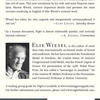3: Back cover, Elie Wiesel’s "Night," Hill & Wang edition, 2006.
The two one-sentence reviews on the back cover of Night point to the complex task of defining and describing Holocaust testimony. In particular, these reviews demonstrate how genre can define and delimit the interpretation of a text.
Suggested Activity: First, ask students to write their own one-line reviews of Night. Students can then compare and contrast their reviews. Next, ask students to examine the back cover of the Hill & Wang edition and to read the two one-line reviews found there. How are the reviews similar to and different from each other, and from the ones the students wrote? Ask students to break into two groups for a debate. Assign the genre “art” to one group and “document” to another. Ask each group to argue that Night is either “art” or “document.” Then bring the students back together for a group discussion. Ask them to consider the following: What are the advantages or disadvantages of classifying Night as “art” or “document”? How does it change our perception of the text? How do we engage with “art” and “documents” differently? Are the two categories mutually exclusive? If Night is indeed a document, is it “beyond criticism,” as A. Alvarez says in his one-line review?
Source: Elie Wiesel, Night, trans. Marion Wiesel (New York: Hill & Wang, 2006), back cover.

